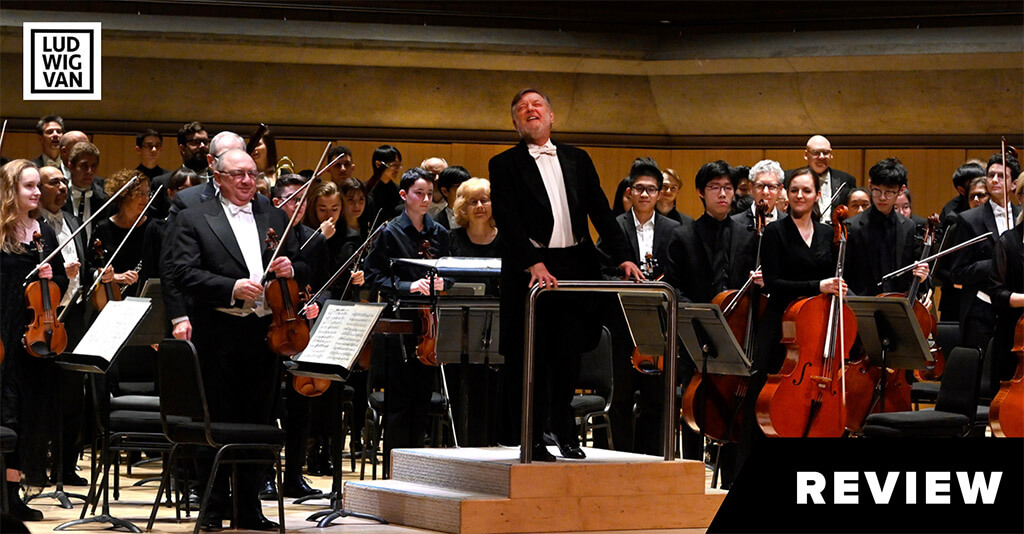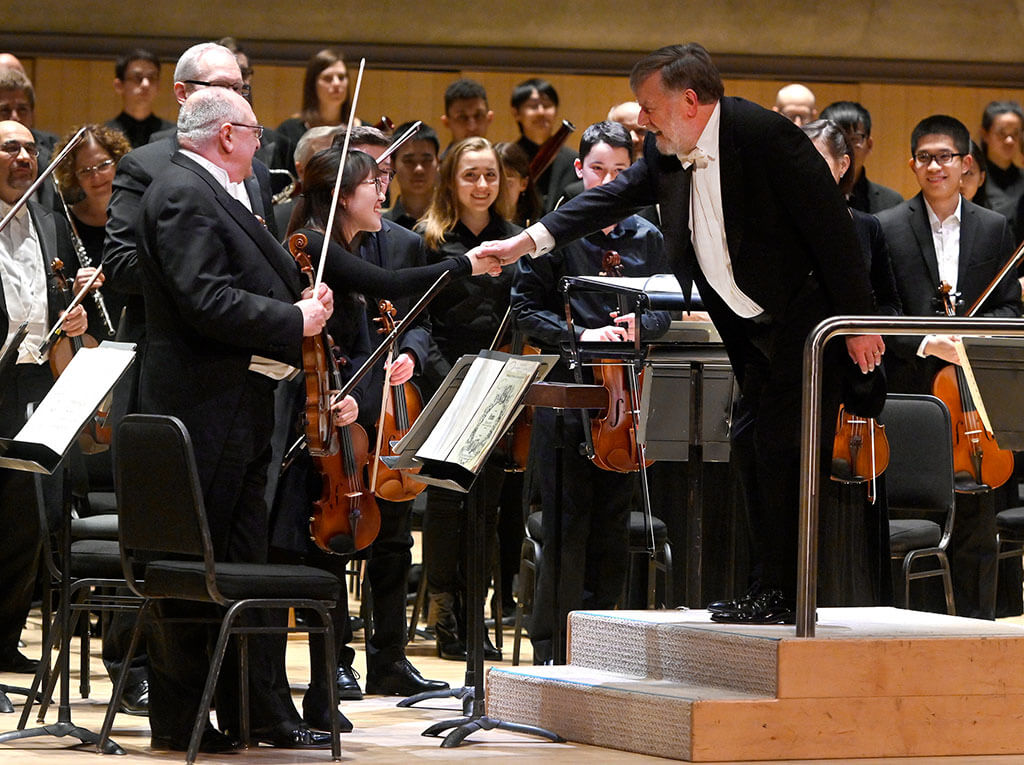
Toronto Symphony Orchestra featuring members of the Toronto Symphony Youth Orchestra. Sir Andrew Davis, conductor. At Roy Thomson Hall, February 6, 2019. Repeats Thursday, Feb. 7 and Saturday, Feb. 9. Details, here.
One of my favourite concert experiences over the years is always attending combined orchestra events that can only take place in cities large enough to bring together a flagship philharmonic with its companion youth orchestra. With players from the highly regarded Toronto Symphony Youth Orchestra (TSYO) paired with their doppelgängers in the Toronto Symphony Orchestra (TSO), desks got a little cramped in places, but the sound matched the visual thrill of seeing the stage so crowded.
And no one seemed more delighted with it all than TSO conductor laureate Sir Andrew Davis, who showed us a grand night of music-making from first note to last, most conspicuously in Dvorák’s Sixth Symphony. He led everyone off with Carnaval Overture op. 2 by Oscar Morawetz, a huge Canadian favourite of the Godfrey Ridout Fall Fair variety, and the combined orchestras made the most of it in every section of the big ensemble. The audience ate it up — they knew how good it was.
That summed up the rest of the evening too. Sir Andrew next took us on a two-part tour of Vienna in the 1880s and prior to conducting the Dvorák, he presented Brahms’ Double Concerto with two fine featured soloists, TSO concertmaster Jonathan Crow, who took on the work with the required authority, and the no-less-commanding TSO principal cellist Joseph Johnson.
Described at the time of its première as one of the more morose compositions ever written by Brahms, it was never popularly received until very recently. Nineteenth-century ears heard it as a mildly dissonant piece with scrappy bow work for the cello spiced with some technically difficult passages beyond the audience’s listening capabilities.
Nothing could be further from the truth for our times. If anything, programming the lyrical and often reflective Brahms Double gives us a chance to hear the composer’s last orchestral work from a new vantage point that is in some ways separated from the four symphonies, while in other ways it pays tribute to them with a fresh scope of ideas both quotational and brand new, all the while ensconced with inventive sonorities that take a view toward his nostalgic late-style chamber pieces. It’s a shame Brahms burned the sketches for a second Double Concerto; he was so dejected by the initial public reception toward his first concerto in this sub-genre.

On the outside, the orchestral playing was taut but smooth, filled with creamy phrasing in the more melodically extroverted sections, particularly the strings from whom the score demanded some blue-collar bow work. But on the inside, Crow and Johnson seemed busy dialoguing with each other, separated by a different musical language of gentle, hyper-sweetened sonority.
This was a considered approach to the work, in contrast to some of the astringent timbres voiced by twentieth-century recordings a half-century ago, or more contemporary, less well-considered live performances elsewhere of late. It’s encouraging to see it all changing these past ten or fifteen years, when a polished young duo like Crow and Johnson elect to offer something more thoughtfully constructed, lyrical, and ultimately opt for presenting a kind of intimate duet with a rich orchestral timbral accompaniment as commentary. The effect was excellent, mostly so in the second and third movements. Please go and see this — it’s not performed as often as the other larger works of Brahms, and the TSO and Sir Andrew Davis do the work justifiable credit.
The concert’s second half was considerably more uptempo and equally delightful. Evoking a past era of dancing and social pleasures, Dvorak’s first grand Viennese masterpiece blended jaunty Czech modality with the Viennese majestic, and at times bridged some of the new music language found in Liszt and Wagner with a burnished eclectic palette. There are even momentary tributes to Beethoven, too, especially in the first movement.
As we all expected, the orchestra presented another well-rounded performance, with broad attacks in strings, delicate but full wind ensemble textures throughout the first movement, and the double basses shone yet again, this time most conspicuously in the fourth movement. Echoes of Brahms’ Second in offset wind and brass chords, key modulations, and especially in the relaxed country atmosphere of the many different motives, all characterized a symphony full of ideas that sat comfortably together with one another in close quarters.
After the beautifully played B-flat major Adagio, Davis transitioned to the third movement with an interpretive smoothness, easily guiding the audience into a folksy “Furiant” which jaunted along with curious but stridently off-accented vigour. From there, it was easy to lead us into a Finale that held its vitality with equitable energy. Not to be underestimated, the string sections were at their most broad in these later movements, demanding more sound space in their down-bow strokes and slightly asymmetrical rhythmic attacks that were so essential to the work’s character which frankly, were very pleasing to hear.
Occasionally, there were some odd, spectrally rough moments to iron out (final cadence of the second movement in the Brahms) and some rather generalized playing where a little more variety of rhythmic attack was needed (end of the development section and coda in the first movement of the Dvorák), but overall the bravos at the evening’s close told the story: this was a concert entirely to be relished.
With more performances Thursday and Saturday, this is an event not-to-be-missed.
LUDWIG VAN TORONTO
Want more updates on Toronto-centric classical music news and reviews? Follow us on Facebook or Twitter for all the latest.
- SCRUTINY | Opera Atelier’s Film Of Handel’s ‘The Resurrection’ A Stylish And Dramatic Triumph - May 28, 2021
- HOT TAKE | James Ehnes And Stewart Goodyear Set The Virtual Standard For Beethoven 250 - December 15, 2020
- SCRUTINY | Against the Grain’s ‘Messiah/Complex’ Finds A Radical Strength - December 14, 2020



